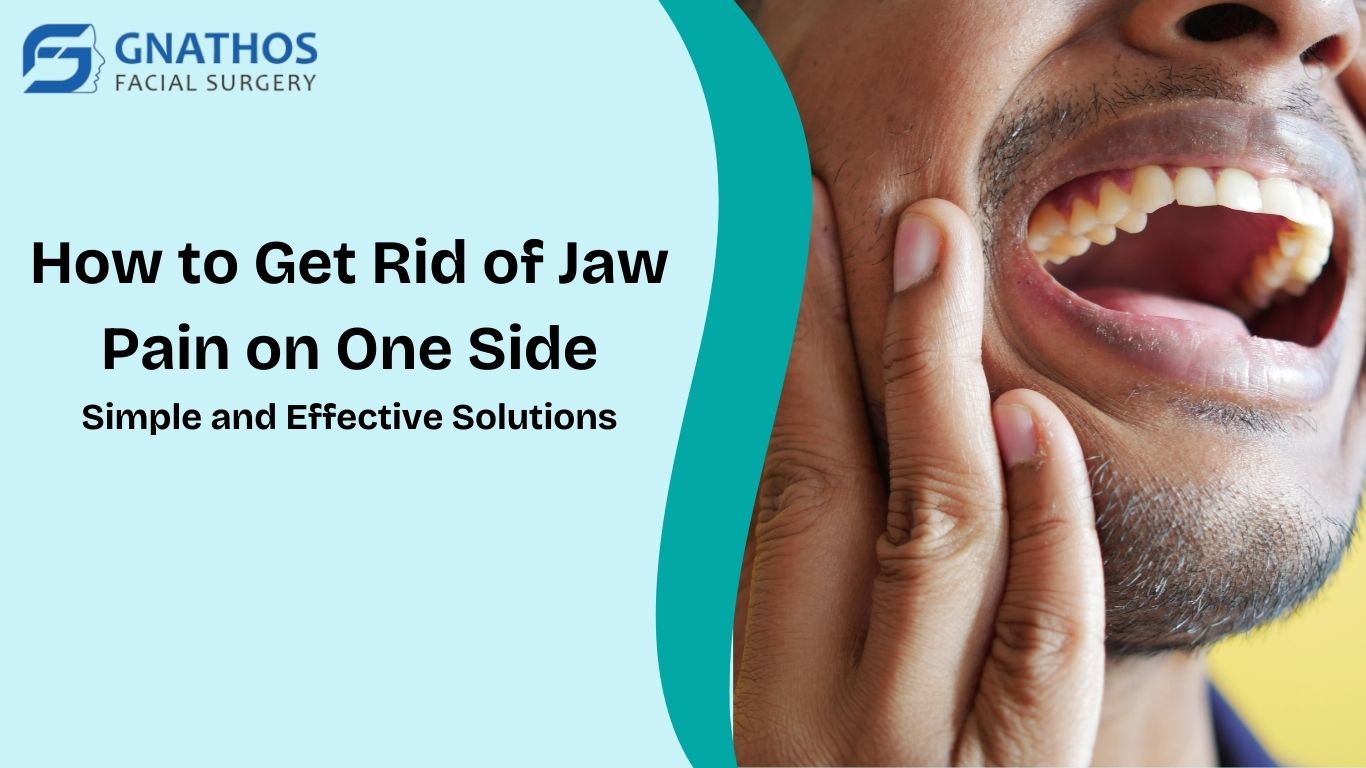How to Get Rid of Jaw Pain on One Side: Jaw pain on one side can be both painful and frustrating, affecting your ability to eat, speak, or even smile comfortably. Whether the pain is sharp, dull, or constant, dealing with it daily can disrupt your routine and affect your quality of life. You might be wondering how to get rid of jaw pain on one side. The good news is, that there are several ways to alleviate jaw pain, ranging from home remedies to medical treatments.
In this blog, we will dive into the possible causes of one-sided jaw pain, the best methods for relieving it, and practical tips you can start using today. Whether your jaw pain is due to tension, injury, or an underlying condition, we’ll guide you through the solutions that can provide fast and lasting relief.
What Causes Jaw Pain on One Side?

Before we get into the solutions, it’s essential to understand the possible causes of jaw pain on one side. Jaw pain can be caused by a variety of factors, ranging from temporary discomfort to more serious underlying conditions. Some of the most common causes include:
1. Temporomandibular Joint Disorder (TMJ)
One of the most frequent causes of jaw pain is TMJ disorder (TMD), which affects the joint that connects your jawbone to your skull. This condition can cause pain and discomfort in one or both sides of the jaw. TMJ disorders can result from teeth grinding, jaw clenching, misalignment, or even stress.
2. Bruxism (Teeth Grinding)
Teeth grinding, or bruxism, often occurs during sleep and puts significant strain on the jaw. Over time, grinding your teeth can lead to muscle fatigue, inflammation, and jaw pain on one side of the face.
3. Jaw Injury
A previous injury to the jaw, such as a fracture or dislocation, can cause localized pain on one side. Even a mild injury can lead to discomfort, swelling, or difficulty moving your jaw.
4. Sinus Infection
A sinus infection (sinusitis) can also cause pain around the jaw, particularly on one side. The sinus cavities are located close to the jaw, and inflammation or infection can cause referred pain to the jaw.
5. Dental Issues
Sometimes, the cause of jaw pain on one side can be traced to dental problems such as tooth infections, abscesses, cavities, or impacted wisdom teeth. Infections or severe dental issues can radiate pain to the jaw, often affecting one side more than the other.
6. Arthritis
Arthritis, including osteoarthritis and rheumatoid arthritis, can affect the temporomandibular joint, leading to pain and stiffness on one side of the jaw. This type of pain is often accompanied by swelling and difficulty moving the jaw.
7. Infections or Abscesses
Infections in the gums, teeth, or joints can also lead to pain in the jaw. An untreated dental abscess or gum infection can spread to the jaw area and cause localized discomfort.
8. Stress and Tension
Chronic stress or anxiety can cause the muscles around your jaw to tighten, leading to pain and discomfort. If you find yourself clenching your jaw due to stress or anxiety, this can contribute to one-sided jaw pain.
For the best jaw treatment in Hyderabad, visit Gnathos Face. The clinic offers expert jaw surgery and facial corrective procedures with advanced techniques. Experienced surgeons ensure personalized care and effective results.
How to Get Rid of Jaw Pain on One Side: Simple and Effective Solutions
Now that we’ve discussed the possible causes of jaw pain on one side, let’s explore practical and effective solutions you can try to get rid of the pain. Many of these solutions are easy to implement at home and can provide fast relief.
1. Apply Heat or Cold Compress
One of the simplest and most effective ways to relieve jaw pain is by applying either a heat or cold compress. Both can help reduce pain, inflammation, and muscle tension.
- Cold compress: Apply a cold pack or ice wrapped in a towel to the affected side of your jaw. The cold can help numb the area, reduce inflammation, and provide temporary relief.
- Heat compress: Alternatively, you can apply a warm compress to relax the muscles around your jaw. Heat therapy helps improve blood circulation and reduce stiffness, which can be especially beneficial for muscle-related jaw pain.
Tip: Alternate between heat and cold compresses for 10–15 minutes at a time, several times a day, for maximum relief.
2. Gentle Jaw Exercises
If your jaw pain is due to muscle tension or TMJ disorder, gentle jaw exercises can help relieve discomfort and restore normal jaw function. These exercises can improve mobility, reduce muscle stiffness, and alleviate pain caused by TMJ or teeth grinding.
Here are some simple jaw exercises you can try:
- Open and close your mouth: Slowly open your mouth as wide as possible without causing pain, then slowly close it. Repeat this exercise 10 times.
- Side-to-side movements: Gently move your jaw to the left and right, holding each position for 5 seconds. Repeat 5-10 times on each side.
- Forward jaw movement: Push your lower jaw forward and hold for 5 seconds, then return to the neutral position. Repeat 5-10 times.
Perform these exercises several times a day, but stop if you experience sharp pain or discomfort.
3. Over-the-Counter Pain Relievers
If you’re experiencing mild to moderate jaw pain, over-the-counter pain relievers like ibuprofen or acetaminophen can help reduce inflammation and alleviate discomfort. These medications are often effective for managing jaw pain caused by TMJ, arthritis, or dental issues.
Tip: Always follow the recommended dosage instructions and avoid taking painkillers for extended periods without consulting a doctor.
4. Massage Therapy
Gentle massage can help relieve muscle tension and alleviate pain caused by TMJ, stress, or bruxism. You can use your fingers to massage the muscles around your jaw, temples, and neck. Applying gentle pressure in circular motions can help relax the muscles and improve blood flow.
For more effective results, consider booking a professional TMJ massage with a licensed therapist who specializes in jaw and facial pain.
5. Stress Reduction Techniques
If your jaw pain is related to stress or anxiety, practicing stress-relieving techniques can make a big difference. Stress management can help reduce jaw clenching and muscle tightness, which are common causes of jaw pain.
Try incorporating the following techniques into your routine:
- Deep breathing exercises: Slow, controlled breathing can help calm your nervous system and reduce muscle tension.
- Meditation: Guided meditation or mindfulness techniques can help you manage stress and prevent jaw clenching.
- Yoga: Gentle yoga poses can help relax your body, release tension, and improve posture, all of which can contribute to jaw pain relief.
6. Use a Night Guard
If you suffer from bruxism (teeth grinding), wearing a night guard can help prevent jaw pain caused by clenching your teeth while you sleep. A night guard is a custom-fitted dental appliance that fits over your teeth and protects them from grinding. It also helps reduce strain on the jaw muscles, which can alleviate pain and prevent further damage to the teeth and jaw.
Consult with your dentist to get a custom night guard that fits comfortably and helps reduce jaw pain during sleep.
7. Avoid Chewy or Hard Foods
If you’re dealing with jaw pain, it’s a good idea to avoid foods that require a lot of chewing or force on your jaw. Hard or chewy foods like gum, raw vegetables, or tough meats can aggravate jaw pain and strain the muscles. Instead, opt for soft, easy-to-chew foods that won’t put additional pressure on your jaw.
8. Consult a Dentist or Physical Therapist

If your jaw pain persists or worsens, it’s important to consult with a professional. A dentist or physical therapist can assess your condition and recommend additional treatments, such as:
- Physical therapy for TMJ: A physical therapist can guide you through specialized exercises to relieve jaw pain and restore function.
- Dental treatments: If your jaw pain is related to dental issues like misalignment, cavities, or tooth infections, your dentist can recommend appropriate treatments or even refer you to a specialist.
- TMJ treatment: A dentist specializing in TMJ disorders may suggest treatments like splints, Botox injections, or even surgery in more severe cases.
9. Injections or Surgery (In Severe Cases)
In some severe cases of TMJ or jaw dysfunction, when conservative treatments don’t provide relief, more invasive treatments like corticosteroid injections or surgery may be recommended.
- Corticosteroid injections: These injections can help reduce inflammation and pain in the jaw joint and surrounding muscles.
- Surgical options: In rare cases, surgery may be needed to address underlying structural issues with the TMJ or jaw.
These options are typically considered after all other treatment avenues have been explored.
FAQs
Why does my jaw hurt on one side?
Jaw pain on one side can be caused by a variety of factors, including TMJ disorders, teeth grinding, jaw injuries, dental issues, or even sinus infections. The pain is often related to muscle tension or inflammation around the jaw joint.
How can I relieve jaw pain naturally?
To relieve jaw pain naturally, you can try methods like heat or cold compresses, gentle jaw exercises, stress reduction techniques, and massage therapy. These remedies can help relax the muscles and reduce discomfort.
What is the best way to treat TMJ at home?
At home, you can treat TMJ by using hot or cold compresses, performing jaw exercises, managing stress, and wearing a night guard if you grind your teeth. If symptoms persist, consider seeing a healthcare professional for further evaluation.












